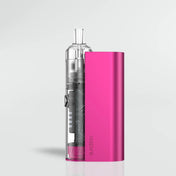E-liquid, also called vape liquid or vape juice, is the substance we vapourise in e-cigarettes to deliver the nicotine containing vapour we then inhale to satisfy our cravings. They come in a variety of different formats, with varying properties suited to different vaping styles. Pairing the right liquid with the right device is a key step in ensuring you are starting your journey properly.
Deciding which e-liquid to choose, particularly when starting out on your vaping journey, can be a daunting process. Not only are there thousands of different brands out there, but there are many different types of e-liquid that all offer different experiences, designed to suit different personal preferences.
It is very common for vapers to switch between different types throughout their journey, however most new starters will tend to opt for 50-50 freebase or nicotine salt e-liquids as they offer the higher strengths that tend to better manage the cravings that come from a heavier smoking habit.
More experienced vapers often progress to thicker HVG e-liquids, which have reduced nicotine strengths owing to the very powerful and more complex devices they are best paired with - some people choose to start their journey this way regardless.
The first step is understanding what goes into an e-liquid, the different types of e-liquid these ingredients create, and how each could fit into your personal journey.
What Ingredients are in an E-Liquid?
E-liquid typically contains four primary ingredients: PG, VG, nicotine & flavouring.
Propylene Glycol (PG)
- PG is a clear, tasteless, and colourless base material used in many common products including inhalers.
- PG is used in e-liquids as it is a very effective carrier for flavourings and nicotine.
- PG is thinner in consistency than VG and produces far less vapour.
- 50/50 vape liquids are made using a higher volume of PG, allowing them to accommodate higher nicotine strengths.
Vegetable Glycerol (VG)
- VG is a clear, slightly sweet, and colourless base material that is used in a massive range of products, from food to hand sanitiser.
- VG is perfect for e-liquids as it helps to create bigger and bolder flavours.
- VG is very thick in its consistency and can produce massive vape clouds.
- Most e-liquids use a balanced combination of VG and PG, as VG is not an effective carrier agent.
Freebase Nicotine
- This is the most common type of nicotine used in e-liquids. It is called “freebase” as the nicotine itself is freely suspended in a base material like PG or VG, however PG is far more common due to its superior properties as a carrier.
- Most freebase nicotine is suspended in PG at 7.2%, this allows manufacturers to accurately blend it into e-liquids to create the various strengths offered.
Nicotine Salts
- Nic salts are a more recent addition to the vaping industry. They work in the same way as freebase nicotine, however during manufacturing, the nicotine is combined with one of a variety of potential “salt acids”. These salt acids neutralise the naturally alkaline pH of the nicotine. The result is an e-liquid that is smooth on the throat and less harsh in taste, even at very high strengths like 18mg & 20mg.
- Nic salts deliver deep, lasting satisfaction far faster and for far longer than is offered by freebase.
- Nic salts come in different forms. Common nic salt varieties include: Nicotine Salicylate, Nicotine Benzoate, Nicotine Ditartrate & Nicotine Levulinate. These different types can create slightly different properties (like a slight cooling effect) but all function in largely the same way.
Flavouring
- Flavourings are what truly bring an e-liquid to life, they come in near limitless varieties.
- They are usually suspended in a base consisting primarily of PG, which allows the flavourings to be properly blended alongside VG to create the finished product.
- They are classed as “food-grade” and are very similar, if not identical to those used in the catering industry. This does not mean you can add vanilla essence for baking to your e-liquid! While similar, many vape flavours like those we use for EDGE products have been specially developed to perform better when vaped.
What Different Types of E-Liquid Are There?
The ingredients above are combined in varying amounts to create the different types of e-liquid available for you to try. The most common categories are 50-50 or HVG, but there are sub-types within these that offer experiences suited to different needs.
Standard (50/50)
- The most commonly used e-liquids, like the EDGE Core range, are typically called “50/50”. This refers to the fact that in most cases these e-liquids will contain an even ratio of PG to VG, which results in a stable mixture capable of supporting nicotine strengths of up to 20mg (which is the regulatory maximum strength).
- Better suited to smaller vaping devices that are designed to support mouth-to-lung (MTL) style of vaping.
- Most pre-filled pod devices will utilise 50/50 recipes in a variety of flavours and strengths.
Nic Salts
- Nicotine Salt e-liquids follow the same principals as 50/50’s and are blended in the exact same way. The primary difference is that they utilise salt rather than freebase nicotine. This offers some benefits including a smooth taste and deep satisfaction even when vaped at higher strengths like those found in the Edge Bar Salts range.
- Due to their rising popularity, there are some manufacturers producing vaping devices that are described as specifically designed for Nic Salt e-liquids – this does not however mean that you need specialised hardware. Nic Salts are compatible with most Mouth-To-Lung (MTL) style devices.
HVG (AKA - 80/20 or 70/30)
- High Vegetable Glycerol (aka HVG) e-liquids are, along with 50/50s, one of the longest standing liquid varieties available to consumers. They utilise a much higher ratio of VG in their recipe. Due to the lower volume of PG, a more effective carrier agent, HVG e-liquids are typically unavailable in strengths beyond 3mg or 6mg.
- Higher strengths of nicotine (12mg and above) are less preferable for HVG juices as vaping them is generally considered be an unpleasant experience due to the large amount of vapour, and ultimately nicotine that is typically inhaled, creating a particularly harsh throat hit.
- HVG e-liquids like EDGE MAX are only compatible with sub-ohm vaping devices, with a coil rating of less than 1.0ohm. These devices are instantly recognisable in most cases due to their large size, often outlandish designs, and detailed user interface - typically used by experienced vapers.
Short Fills
- Shortfills like EDGE Base are a very popular kind of High VG e-liquid that allow the user to purchase much larger bottle sizes as opposed to the traditional 10ml.
- Shortfills are always sold as nicotine-free, which allows them to bypass the regulations that limit the size of nicotine containing e-liquids to a maximum of 10ml.
- To meet consumer needs, the larger bottles are often filled just short of their maximum volume, allowing the user to add separate Nic Shots to create a large volume of their favourite flavour with a customised nicotine strength.
Nic Shots/Nic Salt Shots
- Exclusively intended to be added to short fill products, these are a rare example of a HVG e-liquid that is also high strength, often found in 18mg, and not for isolated consumption.
- The nicotine content is diluted down when added to the base e-liquid in a short fill.
- It is important to match the PG/VG ratio of a shot to the shortfill so as not to dilute the thickness of your e-liquid.
- An example of how to blend a nic shot with a short fill would look like this:
50ml of 0mg, 80/20 short fill base + 1x 10ml, 18mg, 80/20 nic shot = 60ml of 3mg, 80/20 e-liquid.
- Nic Salt Shots function in the same way but utilise salt instead of freebase nicotine.
How Do I Choose the Best Vaping Device and Coil for Me?
Knowing which e-liquid you want to try can really help narrow down the type of device you choose, and vice-versa. Of course, if you still need a device you will need to understand the best coil to pair with it to create your ultimate tailored vaping experience.
To learn more about vaping devices and how each type can work for you, check out the EDGE Best Practice Series: Which Is The Best Vaping Device For Me?
To learn more about coils and how each type fits into your vaping journey, check out the EDGE Best Practice Series: Which Vape Coil Is Best For Me?
Alternatively, you can download our complete Best Practice Guide on How to vape properly.
If your head is spinning from the jargon in this blog, we recommend checking out our FAQs & Jargon Buster, to help you learn the language of vaping.



